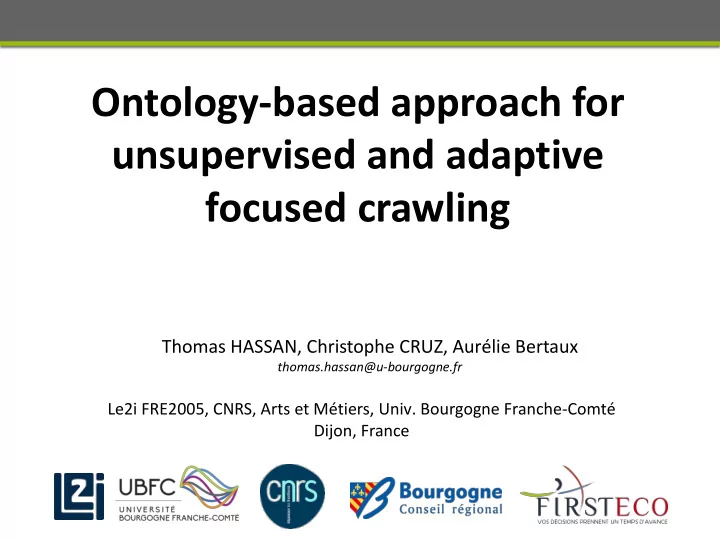

Ontology-based approach for unsupervised and adaptive focused crawling Thomas HASSAN, Christophe CRUZ, Aurélie Bertaux thomas.hassan@u-bourgogne.fr Le2i FRE2005, CNRS, Arts et Métiers, Univ. Bourgogne Franche-Comté Dijon, France
Outline • Context § Industrial context § Problem statement • Proposed solution § Background § Architecture • Evaluation § Scaling § Performance • Conclusion and future work
Industrial context Competitive intelligence 3
Industrial context Content feed tools Content analysis
Problem statement Content feed tools Content analysis Bottlenecks : - Cross-referencing articles to assess veracity - Manual classification of articles - Discrepancy between data and knowledge base High time cost for experts, possible loss of information
Problem statement • How to specialize feed tools with domain-specific knowledge ? • How to optimize content gathering to find most relevant items fast ? • How to expand information sources horizon ? 6
Outline • Context § Industrial context § Problem statement • Proposed solution § Background § Architecture • Evaluation § Scaling § Performance • Conclusion and future work
Background : focused crawler Relevant Irrelevant Seed item Inlink 8
Background : focused crawler + semantics Web Crawler Ontology Efficient content gathering Relevant content analysis 9
Limitations 1) Dynamic data VS static ontology : Discrepancy between ontology-based classifier and actual web data 2) Crawler should improve from experience : Both content and graph mining should be useed to enhance crawling performance Objectives : adapt both crawling experience and content analysis over time to accelerate crawling and improve relevance 10
Architecture : baseline implementation Based on Nutch, hadoop-based distributed crawler • Crawl web sources periodically • High throughput, fault tolerance • Integrate usefull modules Diagram from : https://nutch.wordpress.com/ 11
Architecture : classification module Classification model construction based on probability distribution of features HMC with Tree HMC with DAG L L term 1 term 2 term 3 term 4 term 5 term 6 term 7 label 1 0 0 5 0 5 25 25 label 2 0 75 0 0 0 75 5 label 3 0 0 75 0 25 0 0 label 4 5 25 25 0 5 93 25 label 5 95 0 0 0 60 0 5 label 6 0 60 0 95 0 0 90 label 7 5 98 5 60 25 0 79 Item Item Multi-label Hierarchical Classification
Architecture : classification module Objective : content-based classification of items HMC with Tree HMC with DAG L L Item Item Multi-label Hierarchical Classification Each document represented as a vector of terms it contains (Lucene) Outputs a vector of labels (relevant concepts of the ontology) for each item
Architecture : priority module Use the context-graph approach to estimate relevance of unseen links. Computes similarity with fetched items based on the distance to relevant items Relevant Irrelevant Inlink Graph layers Diligenti, et al., 2000. Focused Crawling Using Context Graphs. In VLDB (pp. 527-534). 14
Architecture : classification module Integration with the crawler 15
Architecture : maintenance module Objective : maintain a cooccurrence matrix of features term 1 term 2 term 3 term 4 term 5 term 6 term 7 label 1 0 0 5 0 5 25 25 label 2 0 75 0 0 0 75 5 label 3 0 0 75 0 25 0 0 label 4 5 25 25 0 5 93 25 label 5 95 0 0 0 60 0 5 label 6 0 60 0 95 0 0 90 label 7 5 98 5 60 25 0 79 16
Architecture : maintenance module 17
Outline • Context § Industrial context § Problem statement • Proposed solution § Background § Architecture • Evaluation § Scaling § Performance • Conclusion and future work
Scaling Distributed architecture to deal with scaling 19
Scaling Distributed architecture to deal with scaling 20
Quality Evaluation Comparison with standard Best-N-First using only cosine similarity 21
Outline • Context § Industrial context § Problem statement • Proposed solution § Background § Architecture • Evaluation § Scaling § Performance • Conclusion and future work
Conclusion • An approach for unsupervised ontology-based focused crawling § Performs cross-referencing of web items § Ontology-based classification model for accurate item classification § Adaptation and evolution of the model using web content and web graph mining • Future work § Evaluation of the architecture in industrial context § Leverage scalability issues of the maintenance process. § Active learning integration in the maintenance process (expert feedback) 23
Ontology-based approach for unsupervised and adaptive focused crawling Thank you ! Thomas HASSAN, Christophe CRUZ, Aurélie Bertaux thomas.hassan@u-bourgogne.fr Le2i FRE2005, CNRS, Arts et Métiers, Univ. Bourgogne Franche-Comté Dijon, France
Recommend
More recommend